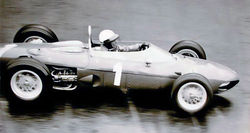Ferrari 156 Sharknose
| Ferrari 156 "Sharknose" | |
| Ferrari 156 | |
|---|---|
| Manufacturer: | Ferrari |
| Production | 1961-1963 |
| Predecessor | |
| Drive | Rear Wheel Drive |
| Chassis | Tubular Spaceframe |
| Class | Formula 1 |
| Body style | Racecar |
| Engine | 1.477 litre Dino Type 156 120º V 6 2 valves per cylinder DOHC |
| Power | 190hp @ 9,500rpm |
| Transmission | Ferrari Type 543/C 5 speed Manual |
| Similar | Ferrari 250 TR 61 Spyder Fantuzzi Ferrari F430 |
The Ferrari 156, affectionately dubbed "sharknose" due to its characteristic air intake "nostrils", was a racecar made by Ferrari in 1961 to comply with then-new F1 regulations that lowered engine displacement from 2.5 to 1.5 litres. It was designed by Carlo Chiti and was the first mid-engined racecar by Ferrari. It is one of the most iconic racecar shapes and one of the most distinctive of all Ferraris. Phil Hill won his only Formula One Driver's World Championship in it and the car also secured Ferrari their first Formula One World Constructor's Championship. In 'good' Ferrari tradition all the sharknose 156s were scrapped at the end of the 1963 season. Pop-singer Chris Rea built a meticulous replica of a sharknose.
Sharknose
The 1961 version was affectionately dubbed "sharknose" due to its characteristic air intake "nostrils". Then-Ferrari factory policy inevitably saw all the remaining sharknose 156s scrapped by the end of the 1963 season. Nevertheless such an F 156 is exhibited in the "Galleria Ferrari" at Maranello, probably a replica. A similar intake duct styling was applied over forty years later to the Ferrari F430.
1963 Ferrari 156 Aero
The updated Ferrari 156, used in the 1963 season, did not feature the distinctive sharknose design but had a rather conventional intake, somewhat larger than the Ferrari 158 introduced in 1964.
Monza Crash
On September 10, 1961, After a collision with Jim Clark's Lotus on the second lap of the Monza Grand Prix, Wolfgang von Trips' (Hill's teammate) 156 became airborne and crashed into a side barrier, fatally throwing him from the car, and killing fourteen spectators.
Famous Drivers
Gallery

| Ferrari Formula One cars | |||||||||||||||||||||||||||||||||||||||||
| 40s | 1950s | 1960s | 1970s | ||||||||||||||||||||||||||||||||||||||
| 8 | 9 | 0 | 1 | 2 | 3 | 4 | 5 | 6 | 7 | 8 | 9 | 0 | 1 | 2 | 3 | 4 | 5 | 6 | 7 | 8 | 9 | 0 | 1 | 2 | 3 | 4 | 5 | 6 | 7 | 8 | 9 | ||||||||||
| 125 | 275 340 375 |
500 | 553 625 |
555 D50 |
801 | 412 246 |
256 | 156 | 158 1512 |
312 | 312 B | 312 T | |||||||||||||||||||||||||||||
| 1980s | 1990s | 2000s | |||||||||||||||||||||||||||||||||||||||
| 0 | 1 | 2 | 3 | 4 | 5 | 6 | 7 | 8 | 9 | 0 | 1 | 2 | 3 | 4 | 5 | 6 | 7 | 8 | 9 | 0 | 1 | 2 | 3 | 4 | 5 | 6 | 7 | 8 | 9 | ||||||||||||
| 312 T | 126 C | 156/85 | F1/86 | F1/87 | 640 | 641 | 642/643 | F92A | F93A | 412T | F310/B | F300 | F399 | F1-2000 | F2001 | F2001 F2002 |
F2002B F2003-GA |
F2004 | F2004M F2005 |
248 | F2007 | ||||||||||||||||||||